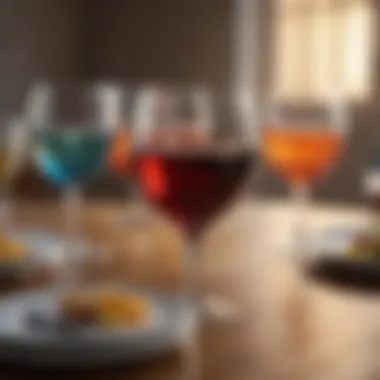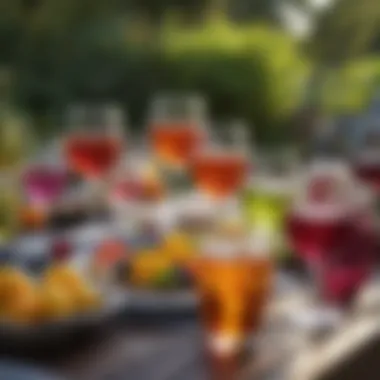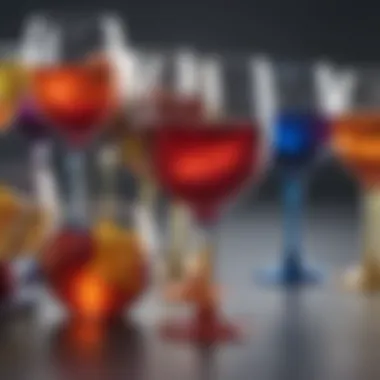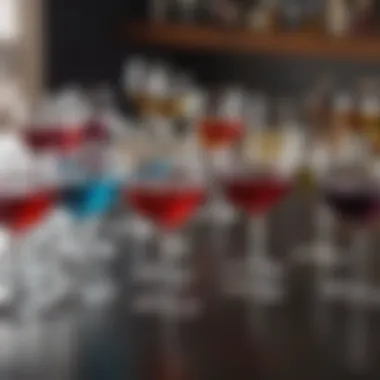Discover the Versatility of Colored Plastic Wine Glasses


Intro
Colored plastic wine glasses are changing how people view dining and social events. These glasses combine style with practicality, offering many options from casual gatherings to formal occasions. Their evolution shows a shift in preferences, as more individuals seek alternatives that blend design with functionality.
Plastic wine glasses are not only durable but also versatile in their uses. They are perfect for outdoor occasions, pool parties, or large events where glass is not ideal. The vibrant colors of these glasses can elevate any setting, adding a pop of cheerfulness to the table.
As this trend continues to rise, it prompts discussions about design choices, production materials, and their environmental implications. The following sections will provide a detailed exploration of colored plastic wine glasses, shedding light on their diverse applications, advantages over traditional glassware, and increasing popularity in various social settings.
Prelims to Colored Plastic Wine Glasses
Colored plastic wine glasses are a product designed for both aesthetic appeal and practicality. Their importance lies not only in their vibrant designs but also in how they have redefined the concept of wine glassware for various occasions. The versatility of these glasses makes them suitable for a wide range of events, from casual outdoor gatherings to more formal celebrations.
One major benefit of colored plastic wine glasses is their ease of use. They can be utilized in settings where traditional glassware may be risky, such as at picnics or pool parties. The lightweight nature of the material reduces strain when carrying multiple glasses at once, enhancing the overall experience for users. In addition, their colorful designs can add a unique flair to any event, matching themes or moods effortlessly.
Considerations when choosing colored plastic glasses include durability and safety. Unlike traditional glassware, these glasses are less likely to shatter, which is particularly valuable in environments with children or active social scenarios.
In summary, the introduction of colored plastic wine glasses represents an evolution in dining and entertaining. They balance functionality with aesthetics, allowing individuals to elevate any occasion without the worry of breakage or heavy lifting.
Versatility in Various Settings
Colored plastic wine glasses have emerged as an essential item across diverse settings due to their functional benefits and aesthetic appeal. Each social environment offers unique requirements, and colored plastic wine glasses meet these needs effectively. Their adaptability is significant, especially in scenarios where breakage and weight pose challenges. Understanding their versatility helps consumers make informed choices that improve their dining experiences.
Outdoor Gatherings
In open-air settings such as picnics, beach outings, and barbecues, colored plastic wine glasses excel due to several factors. First, the lightweight nature of these glasses makes them easy to transport, allowing for convenient packing and setup. This is essential when attending outdoor events where carrying traditional glassware could be cumbersome.
Additionally, colored options add a vibrant touch to outdoor occasions. They enhance the visual appeal of the table setting while allowing hosts to coordinate with themes or festivities. Practicality is also a factor; unlike glass, plastic glassware is resistant to shattering, alleviating concerns about fragile items in lively environments.
Lastly, cleanup is straightforward. After a fun day, disposing of or recycling them minimizes the effort needed for post-event tidying. This blend of aesthetics and practicality positions colored plastic wine glasses as a popular choice for outdoor gatherings.
Formal Events
While traditionally associated with casual settings, colored plastic wine glasses have made their mark in formal events too. Many modern events require a balance between elegance and ease of use. These glassware options offer a solution by providing sophistication without the risk associated with glass.
Hosts often seek to impress their guests, and colored plastic wine glasses can be surprisingly chic. Choices range from sleek, minimal designs to more ornate styles, reflecting the event's theme. For example, a wedding with specific color schemes can utilize matching glasses to reinforce the overall aesthetic.
Moreover, the durability of plastic means hosts can relax about spills or accidents, making the atmosphere more enjoyable. In saying that, a careful selection can elevate the dining experience; many opt for high-quality, stylish options that offer elegance without jeopardizing practicality.
Family Gatherings
Children, particularly, can feel included in festivities when they have appropriate drinkware. With a variety of colors available, they can choose their favorite shades, which enhances their excitement during meals or toasting moments.
Additionally, cleaning and maintenance are incredibly minimal. Their lightweight and sturdy nature means parents can focus on family time instead of worrying about fragile items. This suitability for family-oriented events further underscores the importance of colored plastic wine glasses in enhancing connection and shared experiences during gatherings.
Material Composition
Understanding the material composition of colored plastic wine glasses is critical. The right choice of materials affects not only the functionality and aesthetic appeal of these glasses but also their safety and durability. As consumer preferences evolve, recognizing the significance of what these glasses are made from becomes essential for both manufacturers and users alike.


Types of Plastics Used
Colored plastic wine glasses predominantly use several types of plastics, including polycarbonate, polystyrene, and polypropylene. Each of these materials offers unique characteristics that influence their performance in various settings.
- Polycarbonate: Known for its exceptional clarity and strength, polycarbonate is highly resistant to impact. This plastic can withstand drops and falls, making it suitable for outdoor use. Moreover, it can mimic the look of traditional glass, appealing to those who desire elegance without the fragility.
- Polystyrene: Lightweight and cost-effective, polystyrene is often used for disposable colored plastic wine glasses. While it lacks the durability of polycarbonate, it is suitable for single-use events, such as picnics and parties where convenience is a priority.
- Polypropylene: This plastic is known for its chemical resistance and flexibility. It can be designed in various styles and colors, making it a versatile option. Its sturdiness allows it to hold up well in social gatherings, catering, and family events.
Using these materials enhances the functionality of wine glasses while catering to various consumer needs, from casual users to professional caterers. The choice of plastic impacts the overall experience of using colored wine glasses.
Durability and Safety Considerations
Durability and safety are paramount when selecting colored plastic wine glasses. Choosing the right material ensures that the glasses can endure spills, falls, and the general wear and tear of social events.
- Impact Resistance: Polycarbonate, for instance, is known for its high impact resistance. This feature allows for safe use in environments where breakage is a concern, such as around children or during outdoor events. In these scenarios, the risk of injury from shattered glass is substantially minimized.
- Chemical Safety: Ensuring that materials are safe for drinkware is crucial. Plastics must be FDA-approved to guarantee that they do not leach harmful substances into beverages. Responsible manufacturers conduct thorough tests to ensure compliance with safety standards.
"Colored plastic wine glasses combine style and safety, allowing enjoyment without the risk of breakage common in traditional glassware."
Design Considerations
The design of colored plastic wine glasses is essential in defining their appeal and functionality. It is not merely about aesthetics; the choices made in their design influence user experience, practicality, and even longevity. These factors mold perceptions about quality and usage, impacting consumer preferences significantly.
Color Choices and Aesthetics
Color is a major element in the design of plastic wine glasses. The availability of vibrant shades allows for personalization, making them suitable for different occasions. For instance, bright colors can enhance a festive mood during celebrations and outdoor events. Conversely, more subdued tones can fit beautifully in formal settings. These choices impact the mood set by the tableware.
Aesthetically, the hue can also complement various themes and decor. From a simple picnic to a sophisticated dinner party, colored plastic wine glasses can provide thoughtful color coordination. Their appearance may even affect the perception of the beverage itself, as certain colors can enhance visual appeal. Furthermore, the finish on these glasses, whether matte or glossy, adds another layer to their overall look. Such details can elevate the dining experience, making them more than just functional items.
Shape and Functionality
The shapes of colored plastic wine glasses are equally important. Different forms serve distinct purposes, from stemmed glasses offering elegance to stemless options providing ease for casual settings. The design must also consider the balance between aesthetics and function. A well-designed glass not only looks attractive but also feels comfortable in the hand while providing a stable base.
Additionally, the shape can influence the perceived aroma and taste of the beverage. Glasses designed with a slight taper can enhance the delivery of aromas, enriching the tasting experience. On practicality, lightweight designs ensure ease of use in various settings.
To articulate a practical balance between form and function:
- Stemmed vs. Stemless: Each offers different usability and aesthetic appeal.
- Material Thickness: Affects durability and weight.
- Handle Design: Some glasses may include handles for better grip, especially in outdoor settings.
Advantages Over Traditional Glassware
The growing preference for colored plastic wine glasses is not just a trend; it reflects a significant shift in consumer needs and lifestyles. In comparing these modern alternatives to traditional glassware, several specific advantages become clear, making them increasingly appealing for a wide range of uses. These advantages include considerations of weight and portability, breakage resistance, and cost-effectiveness.
Weight and Portability
One distinct advantage of colored plastic wine glasses is their lightweight design. Unlike glass, which can be heavy and cumbersome, plastic glasses are easy to carry and transport. This feature makes them ideal for various settings, especially outdoor events like picnics, barbecues, or beach gatherings. Lightweight utensils allow users to pack efficiently, reducing the hassle associated with bulky glassware. Therefore, for people who like to host events away from home, colored plastic wine glasses represent a practical choice.
Breakage Resistance
Safety is another crucial aspect where colored plastic wine glasses excel. Unlike traditional glass, which can shatter easily, quality plastic materials provide increased durability. This breakage resistance is particularly important for settings with children or during lively parties. Host have fewer worries about accidents leading to injuries or messy cleanup. In spaces like pools or outdoor festivals, this feature enhances the enjoyment of events with minimal concern about potential hazards associated with fragile glassware.


Cost-Effectiveness
Lastly, colored plastic wine glasses present considerable cost advantages. Many brands offer them at a fraction of the price of comparable glass options. This affordability aligns with budget-conscious consumers who seek quality without compromising style. Moreover, the ability to reuse or recycle these glasses can reduce long-term expenses for those who frequently entertain. By investing in durable, cost-effective plastic options, individuals can enjoy parties and gatherings without the worry usually tied to glassware purchased for one-time events.
Colored plastic wine glasses are not just practical; they represent a cost-effective solution for those who appreciate style while prioritizing functionality.
The analysis of these advantages reveals why colored plastic wine glasses have carved a niche for themselves in modern dining. As lifestyles continue to prioritize both convenience and aesthetic appeal, understanding these benefits becomes essential for consumers looking to elevate their hosting experiences.
Environmental Impact
In the discussion around modern dining ware, the environmental impact of colored plastic wine glasses is an important subject to address. As more people become aware of sustainability and its implications, understanding how these glasses fit into the bigger picture helps to inform responsible consumer behavior. Colored plastic wine glasses, due to their composition and manufacturing processes, engage a modern approach to the intersections of utility and environmental mindfulness. The significance here cannot be overstated, as the shift towards sustainable dining options offers considerable benefits to both individuals and the planet.
Sustainability Considerations
Sustainability is not just a trend; it is a necessary shift in how products are designed and used. In the case of colored plastic wine glasses, many manufacturers are focusing on eco-friendly materials that minimize the environmental footprint.
- Material Sourcing: A growing number of producers are using recycled plastics. This reduces the need for new plastic production, which consumes energy and resources.
- Biodegradability: Some companies are now exploring bioplastics, made from renewable resources. These materials can break down more easily than standard plastics, presenting a less significant long-term burden on landfills.
- Energy Efficient Production: Innovations in manufacturing processes allow for the reduction of energy consumption, which contributes positively to the overall sustainability agenda.
"Sustainable practices are a crucial part of the future of consumer products, including dining ware."
Recycling Potential
Recycling plays a pivotal role in the environmental impact of colored plastic wine glasses. The ability to recycle these items not only conserves resources but also reduces the amount of waste sent to landfills. The recycling potential consists of several layers:
- Post-Consumer Recycling: Many colored plastic wine glasses are made from materials that are recyclable, allowing consumers to dispose of them responsibly.
- Closed-Loop Systems: Some manufacturers implement closed-loop systems where recycled products are used to create new items. This framework fosters a circular economy, ensuring that materials do not simply end up as waste.
- Consumer Education: Increasing awareness among consumers about how to recycle these products correctly has led to higher recycling rates. With proper guidance, people can differentiate which colored plastics can be accepted in local recycling programs.
Understanding the environmental impact of colored plastic wine glasses encourages consumers to make informed choices. As sustainable practices increase, so too does the potential to change consumption patterns, ensuring that dining experiences do not come at the expense of the environment.
Market Trends and Consumer Preferences
Understanding market trends and consumer preferences is essential in evaluating the growing popularity of colored plastic wine glasses. This section will present key insights into how these trends reflect broader societal shifts and influence purchasing decisions.
Popularity Among Millennials and Gen Z
The rise of colored plastic wine glasses coincides significantly with the demands of Millennials and Gen Z. These generations prioritize practicality and aesthetic appeal, both as we move toward more casual social environments and seek unique ways to enhance experiences.
- Convenience is where colored plastic shines. Unlike traditional glassware, these glasses are lightweight, portable, and resistant to shattering. This factor appeals to individuals who enjoy outdoor dining, beach gatherings, and traveling—scenarios where carrying fragile items can be a hassle.
- Aesthetics also play a role. Younger consumers favor vibrant colors and modern designs, which can transform an otherwise simple gathering into a visually exciting event. The ability to match colored glasses with various themes or occasions further elevates their appeal.
Consumers are increasingly drawn to products that not only serve a purpose but also enhance their lifestyle. Colored plastic wine glasses fit seamlessly within this narrative, providing both functionality and style.
Becoming popular on social media platforms, these glasses not only provide utility but also an opportunity for creativity in terms of decor and presentation.
Influence of Social Media
Social media significantly shapes consumer behavior today. Platforms such as Instagram and TikTok showcase lifestyle trends, making it easier for colored plastic wine glasses to gain traction. Users often share images and videos highlighting their social gatherings, featuring these glasses prominently. This effect leads to:
- Brand Awareness: As influencers embrace this product, awareness grows rapidly among their followers. Brightly colored glasses are frequently seen in posts, suggesting they are not just casual items but part of a stylish lifestyle.
- Trend Creation: Social media helps in creating trends. The visuals and engagement techniques used by brands in posts captivate potential buyers, showing how these glasses can enhance their gatherings. Posts utilizing popular hashtags enable more consumers to discover these products.
- User Engagement: Feedback on social media allows brands to gauge consumer preferences effectively. They can use this data to innovate designs and colors that resonate with their audience, ensuring they stay ahead in the market.


Practical Use Cases
The practical applications of colored plastic wine glasses illustrate their growing role in modern dining settings. Their versatility goes beyond simple aesthetics. In various scenarios, these glasses offer unique advantages that cater to real-world needs. Whether in a formal catering environment or relaxing at a beach picnic, understanding their use cases sheds light on their increasing popularity.
Catering Events
Colored plastic wine glasses are especially suitable for catering events. They deliver elegance while being practical. High-end events benefit from the aesthetics these glasses provide. Attendees can enjoy their beverages without the worry of fragile glass cracking. Weddings, corporate gatherings, and fundraisers often require a balance of style and function.
Benefits include:
- Cost-Effectiveness: Renting or purchasing traditional glassware can be expensive. Colored plastic options are typically more affordable.
- Weight Reduction: Serving staff and guests alike appreciate the lightweight nature of plastic glasses.
- Customizable Designs: Many caterers offer options for brand colors or themes. Customization promotes brand identity easily at corporate events.
Additionally, these glasses are disposable or reusable, enhancing convenience in clean-up.
Picnics and Beach Outings
Picnics and beach outings are ideal scenarios for utilizing colored plastic wine glasses. When enjoying nature, practicality is important. These glasses provide a stylish yet functional alternative to glassware. Whether sipping wine on the shore or enjoying a picnic in the park, they enhance the overall experience.
The advantages include:
- Breakable Resistance: Frequent outdoor activities often risk breakage. Plastic wine glasses alleviate this concern.
- Ease of Transport: These glasses stack easily or fit into any cooler, simplifying packing.
- Diverse Color Options: The wide variety of colors allows for creative expression. Coordinating with picnic themes or personal styles adds to enjoyment.
Care and Maintenance
Maintaining the functionality and appearance of colored plastic wine glasses is essential for enhancing their longevity and usability. Proper care and maintenance not only ensure that these glasses remain aesthetically pleasing but also help in upholding hygiene standards. Given their increasing use in various social contexts, knowing how to care for them is crucial for consumers. This section will provide valuable insights into cleaning and storing these glasses effectively.
Cleaning Tips
When it comes to cleaning colored plastic wine glasses, several points merit attention. First, it is advisable to run them through the dishwasher. Most colored plastic wine glasses are dishwasher safe. However, to protect the hues, it is prudent to place them on the top rack. For more delicate or hand-painted varieties, hand washing is the best choice. This approach minimizes the risk of paint fading or chipping. Use warm water with a mild detergent.
- Avoid abrasive pads: These can scratch the surface, causing permanent damage.
- Rinse promptly: After each use, rinsing the glasses removes any residue or stains, preventing buildup.
In case of stubborn stains such as red wine, a mixture of baking soda and water makes an effective paste. Apply it gently and leave it on for a few minutes before rinsing. This method keeps the glass looking vibrant and new. Additionally, ensuring that glasses are completely dry helps to prevent any water spots which may diminish their appearance.
Storage Recommendations
Storing colored plastic wine glasses appropriately is another factor in maintaining their condition. Keeping them in a well-ventilated space reduces the risk of moisture-related issues. Ideally, these glasses should be stored upright; this prevents any warping or bending. If space is a concern, it is advisable to stack them with a small cloth or paper towel between each glass to avoid scratching and pressure marks.
- Avoid direct sunlight: Extended exposure to sunlight can fade colors over time, diminishing the beauty of these glasses.
- Choose stable shelves: Ensure that the storage area is stable enough to prevent any potential falls.
Incorporating these cleaning and storage best practices helps maintain the quality and aesthetic appeal of colored plastic wine glasses over time. By taking care, users can maximize their lifespan while maintaining their versatility across various events and occasions.
Epilogue
The conclusion serves as a significant element in this article by synthesizing key insights and connecting diverse points on the subject of colored plastic wine glasses. The usage of these contemporary dining items transcends from mere utility to a broader cultural symbol in various settings. Understanding this transition emphasizes their importance in both casual gatherings and formal events.
Future of Colored Plastic Wine Glasses
The future of colored plastic wine glasses appears promising as they adapt to evolving consumer preferences. Several factors contribute to this outlook. Firstly, the focus on sustainability will drive the production of eco-friendly materials. Innovations in bioplastics could offer an even more environmentally conscious option for consumers. Additionally, designers are likely to experiment further with shapes and colors, enhancing their aesthetic versatility. Market research indicates that younger generations, especially millennials and Gen Z, are more prone to embrace non-traditional dining ware. Their preference for informal yet stylish options ensures that colored plastic wine glasses will continue to gain traction as practical yet chic choices.
Final Thoughts
Colored plastic wine glasses represent a noteworthy evolution in diningware. They provide a balance of functionality and style. Their practicality is evident in various scenarios, from summer picnics to elegant receptions. These glasses cater not only to the aesthetic desires of consumers but also meet practical needs. As dining experiences evolve, so too does the role of these colorful vessels. They encourage a re-evaluation of traditional expectations surrounding wine glass use. Ultimately, colored plastic wine glasses are not stationary; they symbolize a growing trend towards inclusivity in dining experiences, making them valuable in the discussions surrounding modern dining aesthetics.







